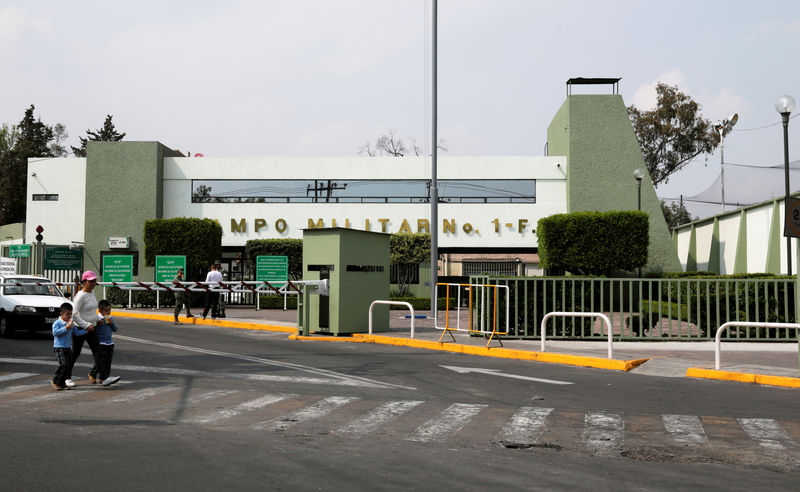 © Reuters. The facade of a military base is pictured in Mexico City
© Reuters. The facade of a military base is pictured in Mexico CityBy Daina Beth Solomon
MEXICO CITY (Reuters) – Mexico’s government is preparing to sell a giant parcel of land that could turn an undeveloped area of Mexico City into one of the most lucrative real estate developments in Latin America with a price tag experts see reaching as high as $1 billion.
Nearly four times the size of Disneyland at 310 acres (125 hectares), the military site is one of the last big swaths of developable land in central Mexico City, a megalopolis with more than 20 million people where land values in coveted neighborhoods have soared.
“It would be the most important development project in Latin America by far,” said Rodrigo Suarez, chief operating officer of Mexican private equity firm Hasta Capital.
“This is going to present a once-in-a-generation opportunity to do a neighborhood from scratch.”
Occupied by an army base with ample green space, according to satellite images, the site sits between the upscale offices and malls of Santa Fe and the posh homes of Lomas de Chapultepec, not far from sleek office and apartment towers developed by Mexican billionaire Carlos Slim in the Nuevo Polanco area.
The possible sale of the site was quietly announced in a document published in the government’s official gazette last month but went largely un-noticed in the media. Inquiries by Reuters show that plans for the sale are now underway.
According to the document, the site is no longer needed by the military and offers no use for other public institutions. Funds from its sale would go to the federal treasury.
The base price would be set by Mexico’s appraisal institute, a government body that manages and values federal property, which did not reply to a request for comment.
A spokesman for a separate federal agency, the administration and property transfer service, which would manage the sale, said it has not yet set a timeline, nor determined the auction type it will use.
The government plans to hire international brokerage Jones Lang LaSalle to market the site, said four Mexico City real estate professionals not affiliated with the company, suggesting aspirations to attract sophisticated investors.
The brokerage declined to comment.
TRUE VALUE
Real estate professionals said the property’s true value is difficult to gauge until the government announces whether it will sell the site as-is or with a zone change that could allow lucrative high-rise construction.
That process may drag into the next administration if it is not finished by the time President Enrique Pena Nieto’s term ends on Nov. 30. A new development with major infrastructure demands in the crowded city may also face stiff opposition.
The frontrunner to succeed Pena Nieto in a July election, former Mexico City mayor Andres Manuel Lopez Obrador, has vowed to prioritize drinking water access, the environment and rebuilding earthquake-hit zones
The leftist might not be amenable to a massive new real estate venture. He has called for work on a new airport in the capital to be scrapped to save money.
If permission is granted for upscale development, foreign institutional investors such as U.S. pension funds and sovereign wealth funds would pounce at the opportunity to invest in one of Latin America’s top markets, local real estate experts said.
Current zoning data from the city’s urban development ministry show a developer could build about 25,100 housing units on the land. With homes in the area selling at a median price of 24,000 pesos ($1,280) per square meter, real estate experts say the site could fetch up to $1 billion at auction.
Such a transaction could make it the priciest land sale ever in Mexico, and one of the largest in Latin America.
Empty land is tough to come by in Mexico City’s crammed urban area. To locate space for large projects, developers often go door-to-door seeking to buy buildings from long-time owners who are frequently reluctant to sell.
Meanwhile, the 2011 emergence of real estate investment trusts known as FIBRAs made the buyers’ market more competitive by providing a steady flow of capital, particularly with backing from Mexican pension funds.
As a result, land values in high-end areas of Mexico City have jumped between 50 and 75 percent over the last five years, according to brokerage Cushman & Wakefield.
But what lures investors could trigger debate among local residents and officials. Such contention exists over the fate of the site of the existing international airport in eastern Mexico City, which is slated to be redeveloped when the new airport is completed.
The military base is smaller than the airport, but could also stir controversy over environmental concerns and competing political interests.
“The city is so dense that anytime you have a big block of space available, that’s a big thing,” said Lyman Daniels, president of brokerage CBRE in Mexico. “But only and if there is good planning and good partnership with the government and the developer.”
Source: Investing.com




























